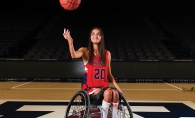Edina High School junior Margeaux Pederson pressed the butt of her shotgun into her right shoulder, using her left hand to take aim. “Pull!” She fired her grandfather’s shotgun, an Ithaca 20 gauge, at a clay pigeon as it leapt into the sky, and—crack! By the end of the 2016 Trapshooting Championship in Alexandria, Minn., the world’s largest youth shooting event with 6,700 competitors, Pederson had hit 61 of 75 clay pigeons. She won the Novice High Gun Female Championship.
Pederson is one of many students in grades six through 12 across the country who have picked up trapshooting. Participants grew from 8,600 to 12,000 between 2015 and 2016, making it the fastest-growing high school sport, according to the USA High School Clay Target League.
Pederson is also one of five girls who participated on the 35-member Edina High School team in 2016.
“I actually didn’t ask any of my scores until I was completely done shooting that day,” she says, although coach Scott Danielson wanted her to know; her performance floored him. Pederson says, “I wanted to just blur out my vision. I wanted to focus on that one disc each time.”
A largely mental sport, trapshooting stands out for its inclusivity.
“It’s gender-neutral and adaptive,” says John Nelson, vice president of the Minnesota Clay Target League. “Kids in wheelchairs can participate right alongside any other kid.” A player needs hand-eye coordination, concentration and stamina. “You don’t have to be athletic, tall or fast to participate.”
Edina High School junior Zoe Cheung has participated in trapshooting since two friends, also girls, persuaded her to join the team during her freshman year. Having never shot a gun before, she was happy to find that the kick didn’t hurt. Now she can shoot upward of 18 out of 25 targets.
Cheung stands 5 feet 4 inches tall and surprises people when she tells them she shoots. “I feel like they think people on the team are all tall, muscular guys who are into hunting.”
Junior Quinn Ramsay grew up in a hunting family. “I catch a lot of [criticism] because I’m a vegetarian, so I didn’t use [my gun] for hunting,” she says. But marksmanship alone is rewarding.
“There’s a strange calmness,” Pederson explains. Although Pederson started out shooting only three targets—“After the first couple shots, I began to panic,” she says of her first round—she asked the volunteer coaches to help her adjust her stance and gun placement, and even how she wore her safety goggles.
Danielson began coaching in 2011 and estimates a 99 percent retention rate. Where hockey players go through $300 replacing sticks in their first four days, trapshooting requires $300 or so for the gear, a league registration fee and a Firearms Safety Certificate from the Minnesota Department of Natural Resources. After that, you’re set to participate into old age.
“I think people overall don’t understand the sport,” Nelson says. The notion is that “kids, guns and schools don’t mix.”
But Minnesota teams practice only at trapshooting facilities, abiding by hundreds of league-mandated safety restrictions. “We have pulled the trigger more than 20 million times and never had a single reported injury,” Nelson says.
For junior Delainey Thorud, safety has become second nature. She keeps the action on her gun open and empty of the free ammunition they receive at the Minneapolis Gun Club in Prior Lake. After a round, Ramsay takes out her earplugs to confer with those shooting next to her.
“It’s becoming less taboo for women to shoot,” Thorud says.
“We can do this just as well, or even better,” Pederson adds. When she won at the championship, she was surprised to find that Nelson had chosen her photo to appear on the award plaque.
The Edina High School trapshooting team kicks off its spring 2017 season in April.









